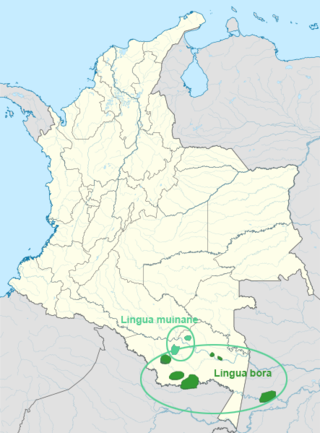
Miskito is a Misumalpan language spoken by the Miskito people in northeastern Nicaragua, especially in the North Caribbean Coast Autonomous Region, and in eastern Honduras.
The Waorani (Huaorani) language, commonly known as Sabela is a vulnerable language isolate spoken by the Huaorani people, an indigenous group living in the Amazon rainforest between the Napo and Curaray Rivers in Ecuador. A small number of speakers with so-called uncontacted groups may live in Peru.

Bora–Witóto is a proposal to unite the Boran and Witotoan language families of southwestern Colombia and neighboring regions of Peru and Brazil. Kaufman (1994) added the Andoque language.

Boran is a small language family, consisting of just two languages.

Páez is a language of Colombia, spoken by the Páez people. Crevels (2011) estimates 60,000 speakers out of an ethnic population of 140,000.

Candoshi-Shapra is an indigenous American language isolate, spoken by several thousand people in western South America along the Chapuli, Huitoyacu, Pastaza, and Morona river valleys. There are two dialects, Chapara and Kandoashi. It is an official language of Peru, like other native languages in the areas in which they are spoken and are the predominant language in use. Around 88.5 percent of the speakers are bilingual with Spanish. The literacy rate in Candoshi-Shapra is 10 to 30 percent and 15 to 25 percent in the second language Spanish. There is a Candoshi-Shapra dictionary, and grammar rules have been codified.
Kashinawa, or Hantxa Kuin, is an indigenous American language of western South America which belongs to the Panoan language family. It is spoken by about 1,600 Kaxinawá in Peru, along the Curanja and the Purus Rivers, and in Brazil by 400 Kaxinawá in the state of Acre.
Cocama (Kokáma) is a language spoken by thousands of people in western South America. It is spoken along the banks of the Northeastern lower Ucayali, lower Marañón, and Huallaga rivers and in neighboring areas of Brazil and an isolated area in Colombia. There are three dialects. The robust dialect is known as Cocama, Kokama, Kukama-Kukamiria, Ucayali, Xibitaoan, Huallaga, Pampadeque, and Pandequebo. By 1999, Cocamilla (Kokamíya) was moribund, being only spoken by people over 40.

Minica (Mɨnɨka) Huitoto is one of three indigenous American Huitoto languages of the Witotoan family spoken by a few thousand speakers in western South America.

Murui Huitoto is an indigenous American Huitoto language of the Witotoan family. Murui is spoken by about 1,100 Murui people along the banks of the Putumayo, Cara-Paraná and Igara-Paraná rivers in Colombia. In Peru it spoken in the North alongside the Ampiyacu and Napo rivers by some 1,000 people. Some Murui speakers live also outside their territories, for instance the vicinity of Leticia, Amazonas, Colombia.
Andoque is a language spoken by a few hundred Andoque people in Colombia, and is in decline. There were 10,000 speakers in 1908, down to 370 a century later, of which at most 50 are monolingual. The remaining speakers live in the area of the Anduche River, downstream from Araracuara, Solano, Caquetá, Colombia; the language is no longer spoken in Peru. Most speakers shifted to Spanish.
The Cacua language, also known as Kakua or Kakwa, is an indigenous language spoken by a few hundred people in Colombia and Brazil. There are many monolinguals, especially children. Apart from being close to or a dialect of Nukak, its classification is uncertain.

Ocaina is an indigenous American language spoken in western South America.

Muinane is an indigenous American language spoken in Colombia.
Aikanã is an endangered language isolate spoken by about 200 Aikanã people in Rondônia, Brazil. It is morphologically complex and has SOV word order. Aikanã uses the Latin script. The people live with speakers of Koaia (Kwaza).

Harakmbut or Harakmbet is the native language of the Harakmbut people of Peru. It is spoken along the Madre de Dios and Colorado Rivers, in the pre-contact country of the people. There are two dialects that remain vital: Amarakaeri (Arakmbut) and Watipaeri (Huachipaeri), which are reported to be mutually intelligible. The relationship between speakers of the two dialects is hostile.
Witotoan is a small language family of southwestern Colombia and the neighbouring region of Peru.

The indigenous languages of South America are those whose origin dates back to the pre-Columbian era. The subcontinent has great linguistic diversity, but, as the number of speakers of indigenous languages is diminishing, it is estimated that it could become one of the least linguistically diverse regions of the planet.
Hairúya is an extinct Witotoan language that was spoken on the Tamboryaco River, a tributary of the Putumayo River, in southeastern Colombia.











